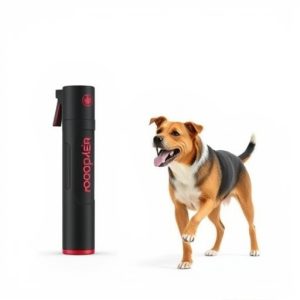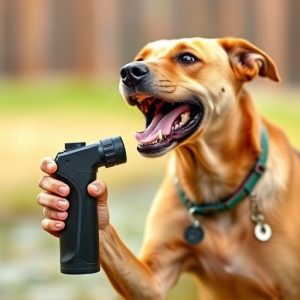Mastering Dog Attack Prevention Pepper Spray Techniques: A Comprehensive Guide
Dog attack prevention pepper spray is a controversial yet effective personal safety tool that tempor…….
Dog attack prevention pepper spray is a controversial yet effective personal safety tool that temporarily disables a dog's senses, providing users with crucial seconds to escape or defend themselves. Choosing the right spray involves considering strength, range, and duration, while practicing techniques through aiming exercises, wind condition understanding, and scenario simulations is vital for effective use in emergencies. Mastering mace spray requires structured training, starting with product manual study, open outdoor practice, fundamental movements, and progressive scenarios, leading to improved comfort, reaction time, and overall effectiveness.
“Unleashing Protection: Dog Attack Prevention Pepper Spray – Your Ultimate Guide. Are you aware that pepper spray can be a powerful tool in deterring dog attacks? This comprehensive guide explores the world of dog attack prevention pepper spray, offering insights into its benefits and legal considerations. We’ll navigate the process of choosing the right spray, mastering application techniques, and providing a step-by-step practice guide to ensure you’re prepared for any unexpected encounter with a canine. Learn how to effectively utilize mace spray techniques, staying safe and confident.”
- Understanding Dog Attack Prevention Pepper Spray: Benefits and Legal Considerations
- Choosing the Right Pepper Spray for Dogs: Factors to Consider
- Mastering Mace Spray Techniques: Safety and Efficacy Tips
- Practicing and Training with Pepper Spray: A Step-by-Step Guide
Understanding Dog Attack Prevention Pepper Spray: Benefits and Legal Considerations
Dog attack prevention pepper spray is a controversial yet effective tool for personal safety. It works by temporarily disabling a dog’s senses, giving the user precious seconds to escape or defend themselves. Unlike traditional mace, which can be difficult to deploy accurately in outdoor settings, pepper spray designed for dogs offers a more targeted and reliable solution.
When considering how to practice mace spray techniques, safety should always come first. Familiarize yourself with local laws regarding the use of pepper spray, as regulations vary widely. Some areas require permits or limit its use to specific situations like self-defense against aggressive animals. Understanding these legal considerations is crucial before investing in and using dog attack prevention pepper spray. Responsible ownership includes knowing when and how to deploy this tool responsibly while adhering to the law.
Choosing the Right Pepper Spray for Dogs: Factors to Consider
When considering dog attack prevention pepper spray, choosing the right product is crucial. Several factors come into play, including the spray’s strength, range, and duration. For dogs, a higher concentration of capsaicin (the active ingredient) may be required to effectively deter an attack. However, this also increases the risk of skin irritation or breathing difficulties if not used properly. Therefore, it’s essential to select a product designed specifically for canine use with instructions tailored to their needs.
Additionally, consider the spray’s range and duration. A longer reach allows for safer distance from the dog, while a long-lasting effect gives you more time to escape. Practicing mace spray techniques is vital. Learn how to aim accurately, understand wind conditions, and practice different scenarios to ensure effective use in an emergency. How to practice mace spray techniques will significantly enhance your ability to protect yourself during potential dog attacks.
Mastering Mace Spray Techniques: Safety and Efficacy Tips
Mastering Mace Spray techniques requires practice and a clear understanding of safety protocols. Start by familiarizing yourself with different types of pepper spray and their application methods. Choose a suitable spray that fits comfortably in your hand, allowing quick access during an emergency. Practice aiming at various distances, focusing on target areas like the face, eyes, and nose—sensitive areas that can disable an attacker temporarily.
When practicing, ensure you’re in a safe, open space where you can safely simulate an attack scenario. Never test pepper spray on people or animals; instead, use mannequins or targets designed for training. Learn to activate the spray with firm, controlled movements, aiming for direct contact with the attacker’s face. Remember, timing and accuracy are critical; you want to disable the threat swiftly while minimizing harm to yourself and bystanders.
Practicing and Training with Pepper Spray: A Step-by-Step Guide
How to Practice Mace Spray Techniques
Before engaging in any practical exercises with pepper spray, ensure you’re familiar with its mechanics and safety precautions. Start by reviewing the product’s user manual, which should outline basic handling and application techniques. Find a safe, open area for practice—a spacious outdoor location away from people, pets, and potential obstacles is ideal. Begin with simple movements: grip the spray can firmly, familiarize yourself with the trigger mechanism, and understand the range of effective dispersal.
Next, practice different spraying angles and distances to get a feel for how the spray pattern changes. Try various techniques like quick bursts, continuous sprays, or targeted pulses. Visualize potential attack scenarios and simulate defensive responses—for example, practicing how to deploy the spray in an upward motion to deter aerial attacks or using it as a temporary shield while you escape. Regular practice sessions will enhance your comfort level and reaction time, making you better prepared to handle unexpected dog attacks effectively with pepper spray.
Dog attack prevention pepper spray is a powerful tool for personal safety, but its effective use requires proper training. By understanding the benefits and legal considerations, choosing the right product, and mastering mace spray techniques through safe practice and training, individuals can significantly enhance their ability to protect themselves against potential dog attacks. Regularly reviewing safety tips and participating in simulated scenarios will ensure users are prepared to respond calmly and effectively when faced with an aggressive dog.


